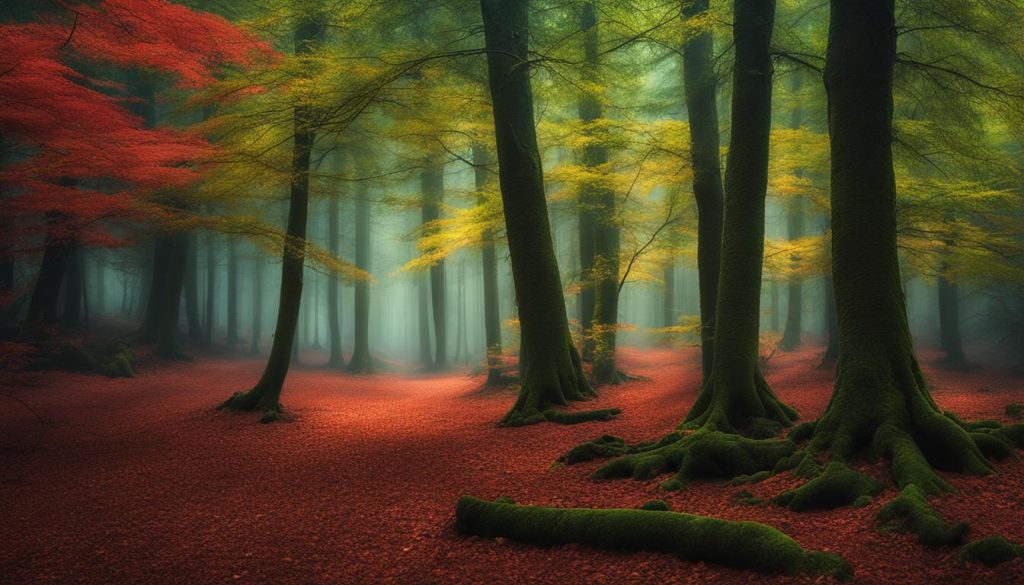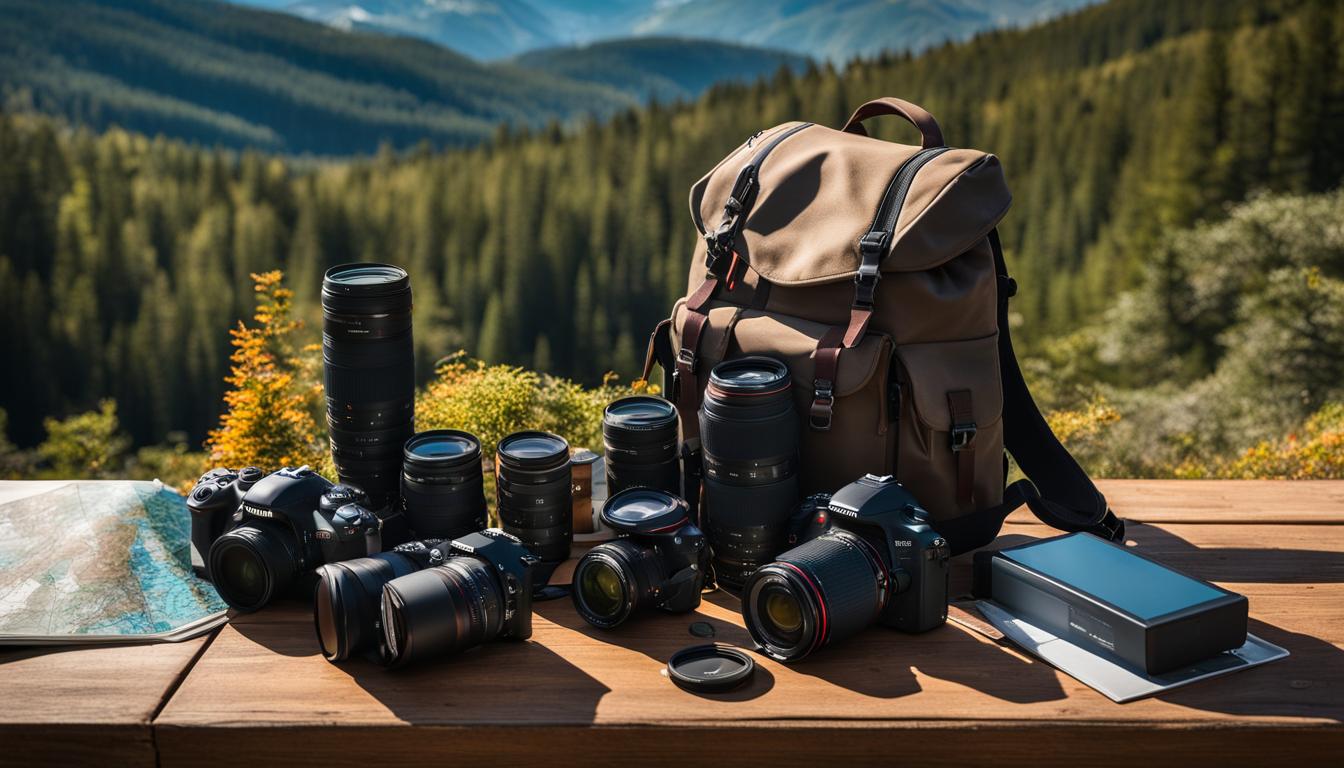Nature photography offers an incredible opportunity to connect with the natural world and showcase its wonders through photography. Whether you’re an aspiring photographer or an experienced pro, capturing the beauty of nature can be a rewarding experience. However, outdoor shoots come with unique challenges, which is why having a nature photography checklist is crucial to ensure you have everything you need to create stunning images.
In this section, we will provide you with a checklist that covers the essential items you need to bring for an outdoor nature photography shoot. From selecting the right camera gear to mastering composition techniques, our checklist will help you prepare for a successful outdoor shoot and elevate your nature photography game.
Key Takeaways
- A nature photography checklist is crucial for outdoor shoots
- Essential items include camera gear, accessories, and tools for planning and research
- Proper planning and research can enhance the quality of your photos
- Mastering composition techniques and understanding light are key to capturing stunning outdoor shots
- Post-processing and editing can take your photos to the next level
Choosing the Right Equipment
Before embarking on your next nature photography adventure, it’s crucial to ensure that you have the appropriate camera gear and accessories for outdoor shoots. Investing in the right equipment can significantly impact your ability to capture stunning images while being comfortable and mobile in the wilderness.
Cameras and Lenses
Your choice of camera and lens will depend on various factors, such as the type of wildlife or landscape you plan to shoot and your budget. For nature photography, a DSLR or mirrorless camera with a high resolution and fast autofocus is ideal, such as the Canon EOS R5 or the Nikon Z7 II. When it comes to lenses, you should consider a range of focal lengths, including a wide-angle lens for landscapes, a telephoto lens for wildlife, and a macro lens for close-up shots of flora and fauna, like the Nikon AF-S VR Micro-Nikkor 105mm f/2.8G IF-ED.
Tripods and Filters
Stability is crucial when it comes to nature photography, especially when working under low-light conditions or using slow shutter speeds. A sturdy tripod, such as the Gitzo GT5563GS Systematic Series 5 Systematic Tripod, is a must-have accessory to keep your camera steady and help achieve sharp images. Filters, such as polarizers and neutral density filters, can also enhance the quality of your shots by reducing glare, enhancing colors, and controlling exposure in bright light.
Bags and Accessories
Gear bags and accessories can make a significant difference in the comfort and convenience of your outdoor shoots. A quality camera bag, like the Peak Design Everyday Backpack, can keep your gear organized and protected while on the go. Additional accessories, such as extra batteries, memory cards, and rain covers, can also help ensure that you’re always prepared for unexpected situations.
By selecting the right nature photography equipment and accessories, you’ll be well-prepared to capture captivating images of the great outdoors.
Planning and Research
If you want to take spectacular nature photographs, planning and research are crucial components to your success. Your preparation stage is vital to ensure that you capture the perfect shot and make the best use of available time during your outdoor shoot.
First, start by selecting your shooting locations. A quick online search with location scouts or photo-sharing platforms like Instagram can offer inspiration on scenic spots and easy access points to ensure the ideal shoot.
Second, research lighting conditions in the area. Familiarize yourself with the sunrise and sunset timings at your chosen location, and use that information to plan ahead and prepare for the best times to take shots.
Next, take note of the time of year and research environmental factors such as the wildlife and flora present, and their patterns and preferences. Understanding animal behavior and birdcall identification will help you get the best results. Knowledge and awareness of safety and ethical practices when photographing in nature is essential.
To help you appreciate the wildlife and flora in your shoot area, we recommend downloading nature apps like iNaturalist or Curio to learn about the local plant and animal species, and to get habitat information.
Incorporating these planning and research tactics into your workflow will greatly enhance your nature photography experience, and increase your chances of capturing unique and compelling images. Happy shooting!
Mastering Composition Techniques
Composition is a vital aspect of nature photography that can make or break a shot. To create visually captivating images, you need to understand how to frame your subject, use leading lines, and apply the rule of thirds for a well-balanced composition.
Framing is a technique that involves using natural elements in the environment to draw attention to the subject. For instance, you could frame a mountain with overhanging branches or use a natural archway to frame a waterfall. This technique not only highlights your subject but also adds depth and interest to your shot.
Leading lines are another key composition technique that can enhance the visual impact of your photographs. By using natural lines like rivers, tree branches, or rows of flowers, you can guide the viewer’s eye to your subject and create a sense of movement in your images.
The rule of thirds is a rule of thumb that suggests dividing your shot into thirds both horizontally and vertically to create a well-balanced image. This technique ensures that the subject is not placed at the center but slightly off-center, creating a more dynamic composition.
Tip: Experiment with these composition techniques and don’t be afraid to break the rules to create unique and captivating images. Remember, rules are meant to be broken in photography.
Understanding Light and Exposure
Light is a critical component in nature photography. To capture stunning outdoor shots, it’s essential to understand how to work with different lighting conditions. The nature photography light varies depending on the time of day, weather, and location. Here are some tips to help you make the most of natural light when taking outdoor shots.
Shooting during golden hour
golden hour, which happens just after sunrise and an hour before sunset. During this time, the light has a warm and soft quality, which can create stunning images with rich colors and beautiful shadows. Try to shoot during this time to capture nature’s beauty in perfect light conditions.
Dealing with harsh sunlight
Harsh sunlight can create challenging nature photography light conditions. Direct sunlight can create harsh shadows, and the bright light can wash out colors. To avoid these issues, try to shoot in the shade or during cloudy days. If you’re shooting in direct sunlight, use a polarizing filter to reduce glare and reflections. You can also use the exposure compensation feature to adjust the exposure and get a well-balanced shot.
Exposure settings and metering techniques
Exposure plays a crucial role in nature photography, and understanding how to adjust your camera’s settings is essential. Use the exposure settings to control the brightness and darkness of your photo. Adjust the aperture, shutter speed, and ISO to achieve optimal exposure when shooting outdoors. Use the metering techniques to evaluate the light levels and make the necessary adjustments. For example, spot metering is helpful when shooting wildlife and subjects in motion, while center-weighted metering works well for landscapes.
By understanding how to work with different lighting conditions, you can capture stunning nature photographs that showcase the beauty of the outdoors. In the next section, we’ll explore how to photograph wildlife in action, including techniques for capturing animals in motion.
Capturing Wildlife in Action
Wildlife photography is an exciting and challenging genre. Capturing animals in motion requires practice, patience, and a good understanding of animal behaviour and photography techniques.
To freeze motion and capture crisp, sharp images, use a fast shutter speed. Start with 1/500th of a second and increase it if needed. Shooting in burst mode can also help capture animals in motion.
Fast focusing is essential in wildlife photography. Use continuous autofocus mode and focus on the animal’s eyes for a more compelling image. Be familiar with your camera’s autofocus settings and adjust them according to the situation.
Understanding animal behavior is crucial in wildlife photography. Observe the animals from a safe distance to avoid disrupting their natural habitat. Anticipate their movements and wait for the perfect moment to capture an impressive image.
Remember to stay ethical and respectful when photographing wildlife. Avoid disturbing or touching the animals, and always follow the rules and regulations of the area you are photographing.
Capturing animals in their natural habitat requires skill and technique, but the results can be breathtaking. With practice and patience, you can create compelling images that showcase the beauty and diversity of wildlife.
Post-Processing and Editing
After capturing your outdoor shots, it’s time to take them to the next level with post-processing and editing techniques. In nature photography, it’s essential to maintain a natural look while enhancing the beauty of your images. Here are some editing techniques for outdoor shots:
- Adjusting exposure: Use exposure settings to correct under or overexposed areas of your photograph and bring out details in different areas of your image.
- Enhancing colors: Adjust the saturation and vibrancy of colors in your photographs to make them pop and create a more compelling image.
- Fine-tuning details: Pay attention to small details in your photograph, such as sharpness and contrast. Adjusting these details can make a big difference in the final result of your image.
It’s important to note that over-editing can compromise the authenticity of your nature photographs. Avoid oversaturating colors or over-sharpening details, as this can make your images look unnatural and artificial.

One useful tip is to work on your edits in small increments and take breaks to look at your images with fresh eyes. This will help you maintain objectivity and ensure that you’re creating the best possible version of your photographs.
Conclusion
In conclusion, mastering nature photography can be a thrilling and rewarding experience. By following the essential nature photography checklist we’ve provided, you’ll be on your way to capturing stunning outdoor shots. Remember to always choose the right equipment, plan and research your shoots, master composition techniques, understand light and exposure, capture wildlife in action, and post-process and edit your images with care.
It’s important to approach nature photography with a sense of respect for the environment and the wildlife that inhabits it. Always abide by the principles of Leave No Trace and adhere to any rules and regulations set forth by parks and preserves.
As you continue to practice and hone your skills, don’t be afraid to experiment and try new things. The natural world offers endless opportunities for creative expression and discovery.
So get out there and explore the beauty of the wild, and don’t forget to have fun along the way!






